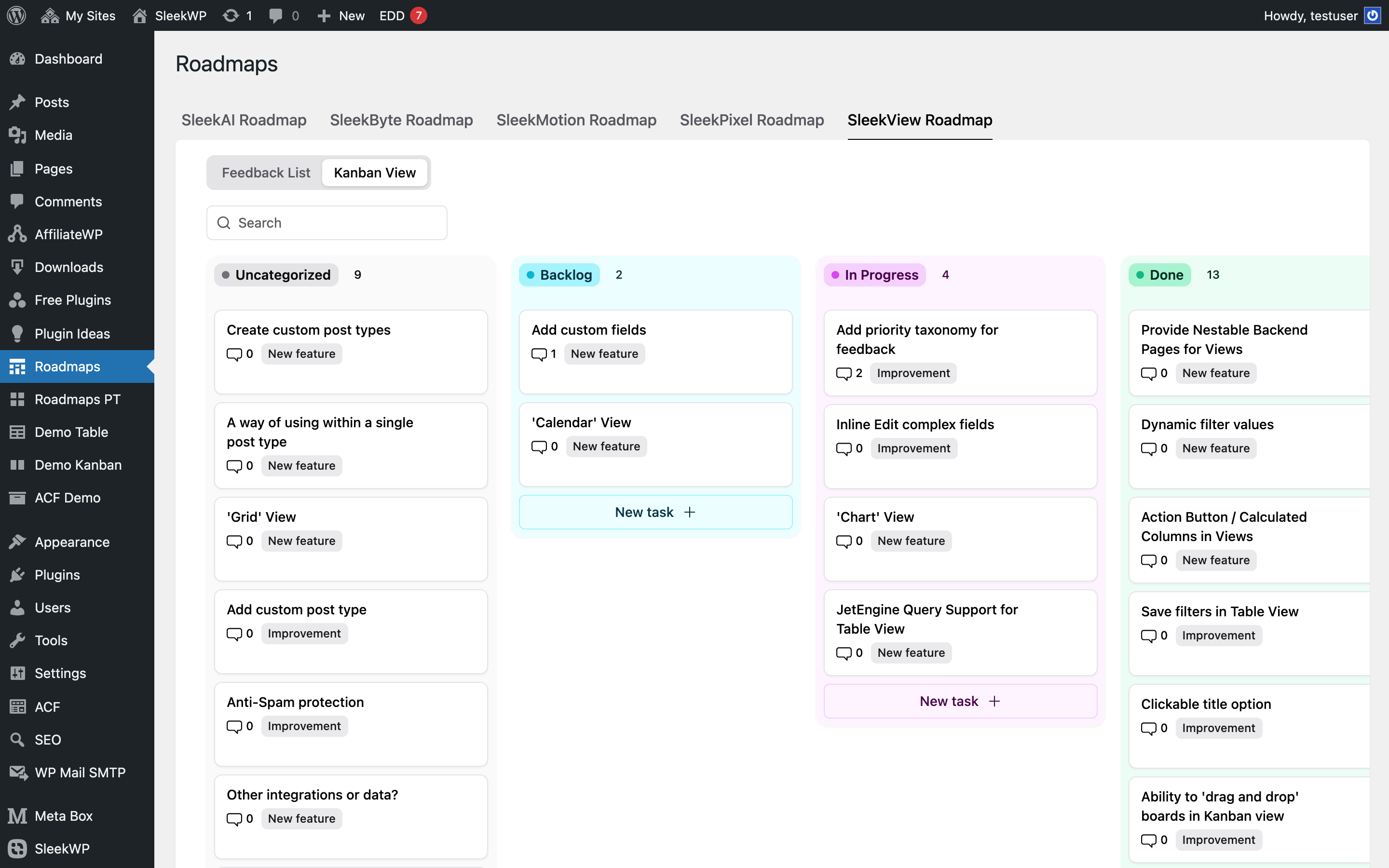Admin Pages
Custom admin pages allow you to compose multiple views together on a single admin screen. This is composition at its finest – combine different post types, mix multiple views, and create personalized dashboards that match your workflow perfectly.

What Makes Admin Pages Special
Unlike standard views which are attached to a specific post type, admin pages are standalone pages in the WordPress admin where you can combine any views you want. The key advantage is that everything stays fully interactive – you can still drag, drop, edit, and manage content directly, just as you would in the individual views.
Creating an Admin Page
To create a new admin page, navigate to the SleekView settings and create a new admin page. The configuration sidebar on the right contains all settings for the admin page:
General Settings
Name
The internal name for the admin page. This is used for identification in the SleekView settings.
Menu Title
The title that appears in the WordPress admin menu sidebar. This is what users will see when navigating your admin area.
Position
The position of the admin page in the WordPress admin menu. Lower numbers appear higher in the menu. Common values:
- 5: Below Dashboard
- 10: Below Posts
- 20: Below Pages
- 25: Below Comments
- 29: Above custom post types (typical placement)
Icon
Choose an icon for the admin page menu item. SleekView uses Ionicons for consistent styling across the admin interface.
Disable admin page
Toggle this option to temporarily disable the admin page from appearing in the admin menu. The configuration is preserved but the page won't be accessible.
Views Section
This is where you compose your admin page by adding multiple views. Each view is displayed as a separate section on the admin page.
Adding Views
Click "Add View" to add a new view to the admin page. Each added view appears as a collapsible section in the Views accordion.
To configure an individual view within the admin page, click the cog icon on that view's section. This opens the view-specific settings:
Name
An optional custom name to override the view's default name. This is useful when you want to display the same view multiple times with different filtering or when you want a more descriptive name in this context.
View
Select which view to display in this section. You can choose from any of your configured views, regardless of which post type they're attached to.
View Organization
Views are displayed on the admin page in the order they appear in the Views section. Use the navigation arrows to:
- Reorder views (move up/down)
- Delete views from the admin page
Use Cases
Custom admin pages excel in scenarios where you need to monitor or manage multiple types of content simultaneously:
Project Management Dashboard
Combine views for:
- Tasks (Kanban view)
- Client communications (Table view)
- Project milestones (Feedback view)
Content Operations Hub
Combine views for:
- Pending articles (Table view)
- Editorial calendar (Kanban view)
- Reader feedback (Feedback view)
Support Center
Combine views for:
- Active tickets (Table view)
- Ticket workflow (Kanban view)
- Feature requests (Feedback view)
Multi-Product Roadmap
Combine views for different products:
- Product A features (Kanban view)
- Product B features (Kanban view)
- Product C features (Kanban view)
Conditions
Like individual views, admin pages support conditions to control visibility. Use conditions to:
- Restrict admin pages to specific user roles
- Show different pages to different user groups
- Create role-specific dashboards
See Conditions for detailed information on setting up conditions.
Best Practices
- Logical Grouping: Group related views together on the same admin page
- Descriptive Names: Use clear menu titles that indicate the page's purpose
- Strategic Positioning: Place frequently used admin pages higher in the menu
- Appropriate Icons: Choose icons that visually represent the page's content
- Role-Based Pages: Create different admin pages for different user roles using conditions
- Start Simple: Begin with 2-3 views and expand as needed
Limitations
While admin pages are incredibly powerful, keep in mind:
- Admin pages only work in the WordPress admin area (they cannot be embedded via shortcode)
- Each view on an admin page uses its own configuration and filters
- Performance may be impacted when displaying many large views on a single page
Custom admin pages transform how you work with WordPress content, bringing everything you need into a single, focused workspace.